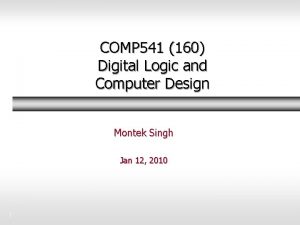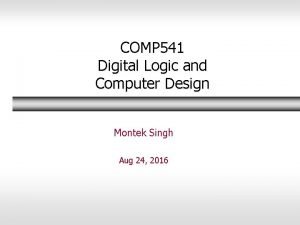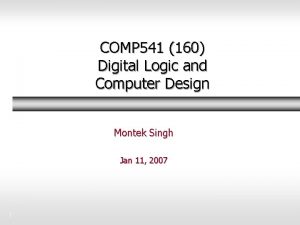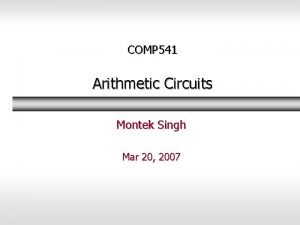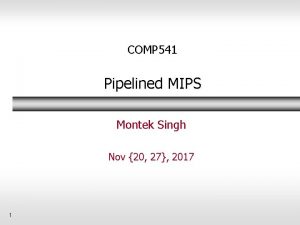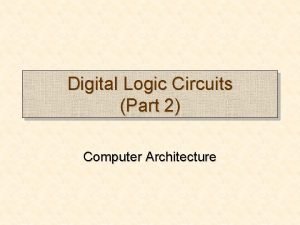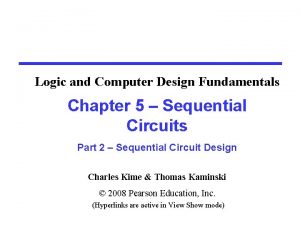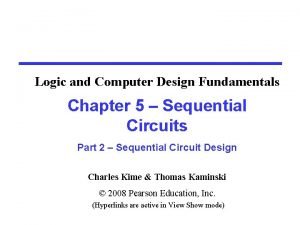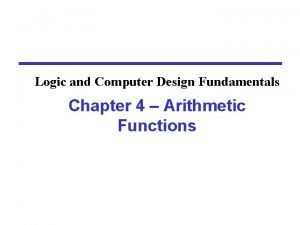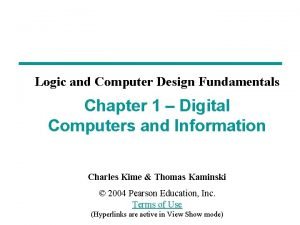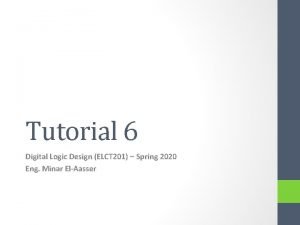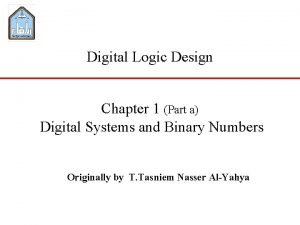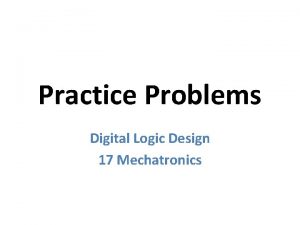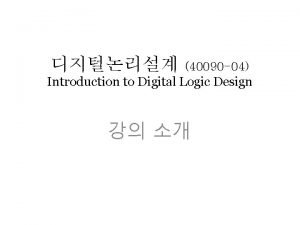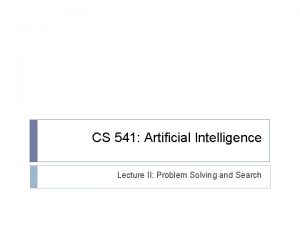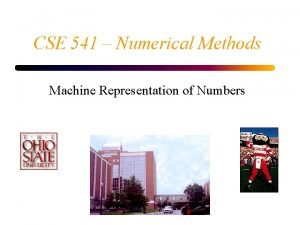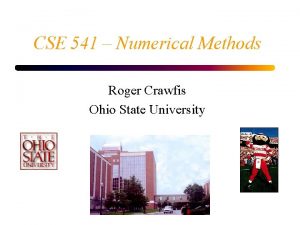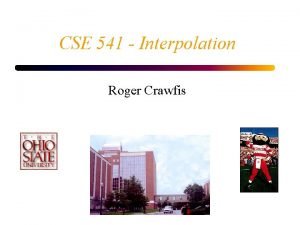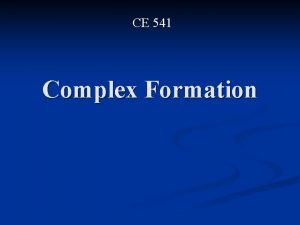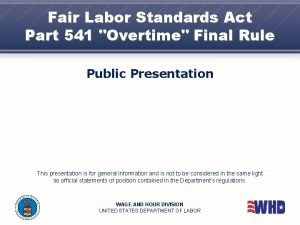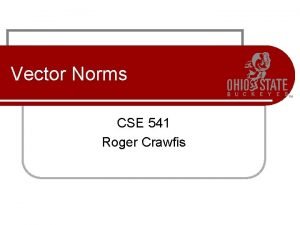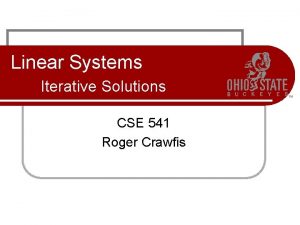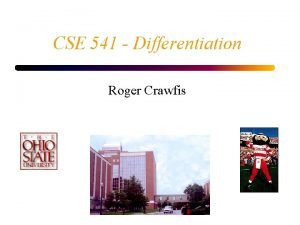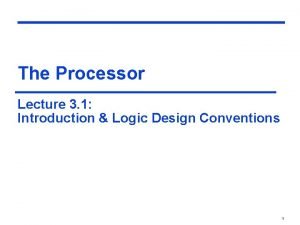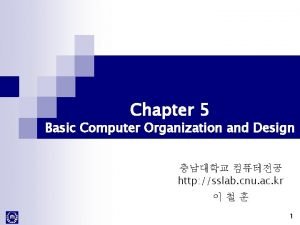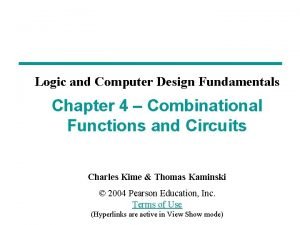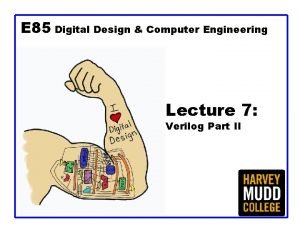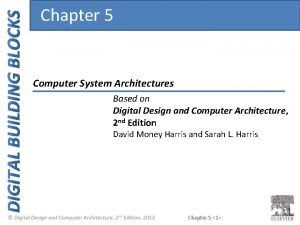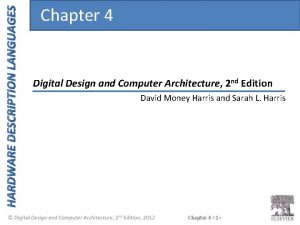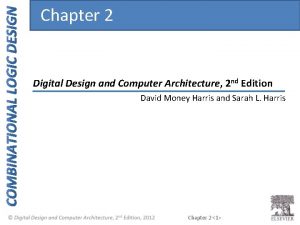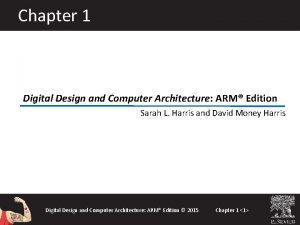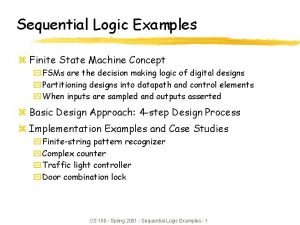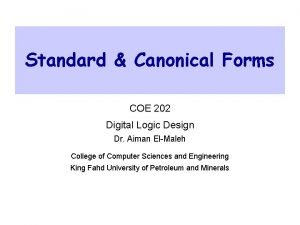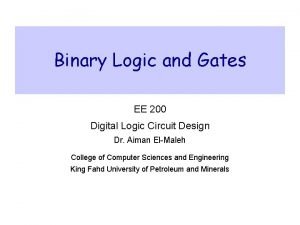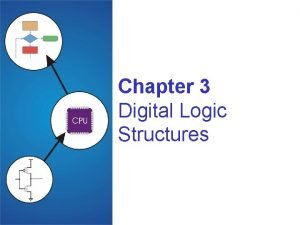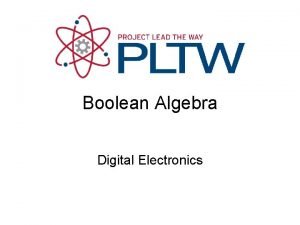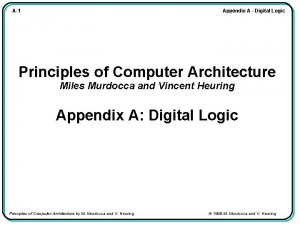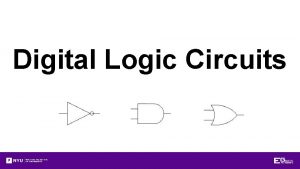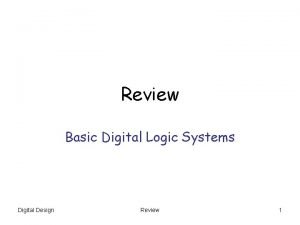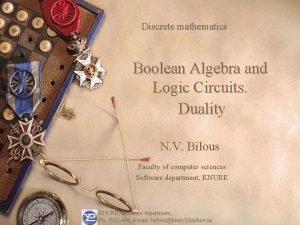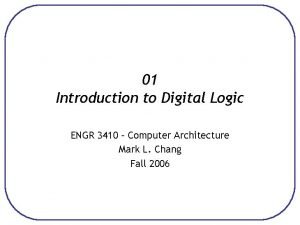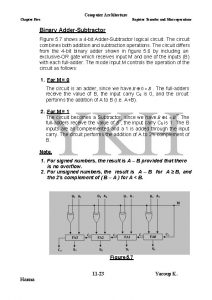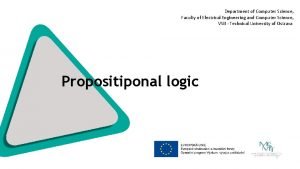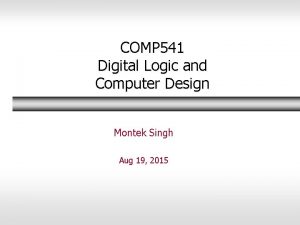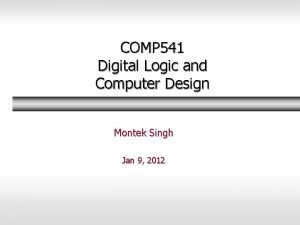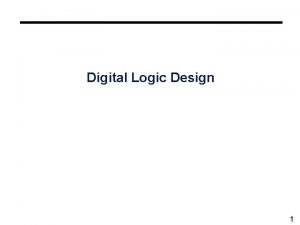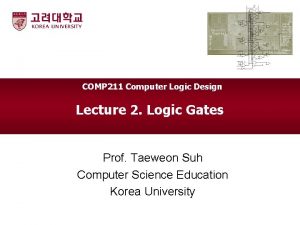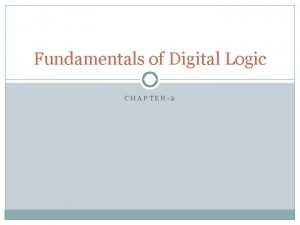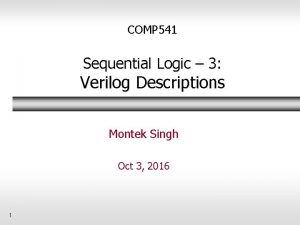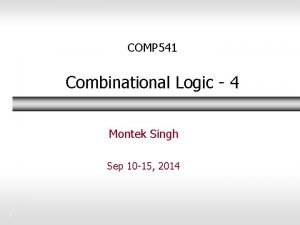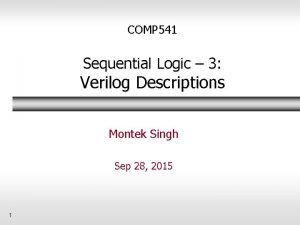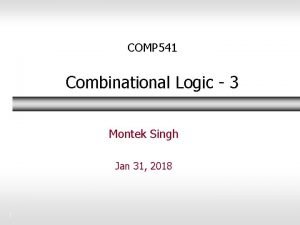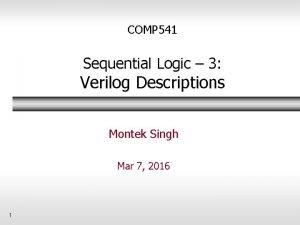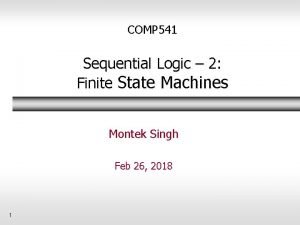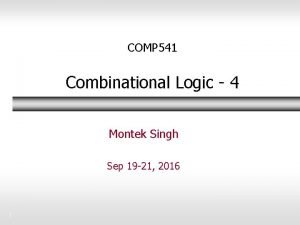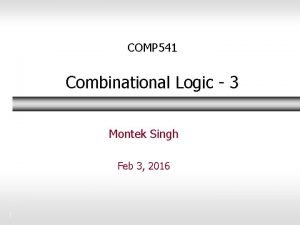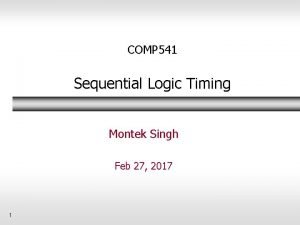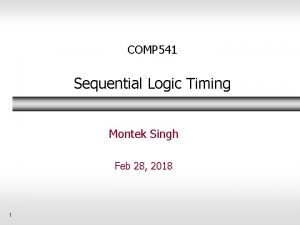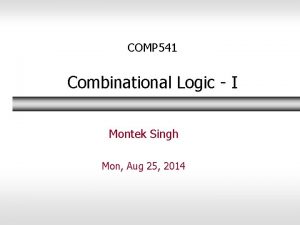COMP 541 160 Digital Logic and Computer Design



























































- Slides: 59

COMP 541 (160) Digital Logic and Computer Design Montek Singh Jan 12, 2010 1

Today’s Topics ã Course description l What’s it about l Mechanics: grading, etc. ã Material from Chapter 1 (self-study review) l What is digital logic? l Binary signaling l Number systems l Codes 2

What’s Course About? ã Digital logic, focusing on the design of computers ã Stay mostly at a high level (i. e. , above transistors) ã Each person designs a MIPS CPU l and peripheral logic (VGA, joystick) l Project like an Atari 2600 game ã High-level language l Modern design practices 3

Focus ã Stay above transistor level l At most one class on transistors and VLSI ã Expect you to know assembly language programming 4

More Than Just Architecture ã Designing and implementing a computer is also about l Managing complexity (hierarchy, modularity, regularity). l Debugging l Testing and verifying 5

The Three -Y’s ã Hierarchy l A system divided into modules and submodules ã Modularity l Having well-defined functions and interfaces ã Regularity l Encouraging uniformity, so modules can be easily reused

How Can We Do This? ã Labs on Fridays ã Use: Field Programmable Gate Arrays (FPGAs) l Chips with a lot of circuits Ø Tens of thousands to millions of transistors l Programmable ã We write descriptions of the design l “programs” describing design ã Tools translate to gates/wires ã Download pattern/interconnection to chip l Sort of like burning music to a rewritable CD 7

We Will Use This Board What’s on it? 8

Schematic Diagram • Old fashioned way to describe logic • Still useful for documentation 9

Verilog /* * A 32 -bit counter with only 4 bits of output. The idea is * to select which of the counter stages you want to pass on. * * Anselmo Lastra, November 2002 */ module cntr_32 c(clk, res, out); input clk; input res; output [3: 0] out; reg [31: 0] count; always @ (posedge res or posedge clk) if(res) count <= 0; else count <= count + 1; assign out[3] = count[28]; assign out[2] = count[27]; assign out[1] = count[26]; assign out[0] = count[25]; endmodule 10

Xilinx Software ã Use design tools from chip maker ã Have full version on lab PCs ã Can install on your PC l Download from web 11

Class Web Pages ã Will be up by Thursday’s class ã Linked from my home page http: //www. cs. unc. edu/~montek ã All lecture slides posted there l Will try to put them there before class ã Schedule, homework, etc. posted there ã Lab documents there also ã See Blackboard for scores/grades 12

Textbook ã Harris and Harris ã Digital Design and Computer Architecture ã Morgan Kaufmann, 2007 ã Amazon has for $70 ã Extra material on http: //www. elsevierdirect. com/companion. jsp? ISBN=9780123704979 13

Overview of Textbook ã Chapters 1 -5: Digital logic l Combinational, sequential, basic circuits, HDL ã Chapter 6: Architecture l Fast – review for those who took COMP 411 ã Chapter 7: Microarchitectures ã Chapters 8: Memories ã Appendix A: Implementation l FPGAs, etc. 14

Order of Topics ã Will change order from that in book l To try to get you working on interesting labs sooner 15

May Also Need ã COMP 411 textbook (Patterson/Hennessy) l For MIPS reference l How many have one? l I can copy the few necessary pages ã Verilog reference l Book optional l Web pages – see course home page 16

Grading ã Labs – 35% l Easier at first; later ones will count more ã Homework – 20% ã Two tests spaced evenly – 12. 5% each ã Final – 20% (optional for some) 17

Labs ã Paced slowly at first l Familiarization with tools, simple combinational design, design a digital lock or similar ã Peripheral – VGA, opt. keyboard interface or joystick ã Build up computer components l Registers, ALU, decoder ã Assemble a simple MIPS ã Add more features, enough for simple computer ã Final demo – game or similar 18

Lab Sections ã No lab this Friday l You need a little more info to begin l Begin next week ã Lab is in SN 027 19

Late Policy ã Homework assignments and lab reports due by class l Labs due on Tuesday after the lab period ã One class late, 10 points off ã Two classes late, 25 points off ã Not accepted later 20

What’s Your Background? ã Course experience ã Work, etc. ã Which COMP 120? ã What’s your intent in taking class? ã Questions? 21

Office Hours ã Would like to wait a week to set ã Send email if you want to meet in the mean time 22

Now Shift to Technology Should be review for all of you 23

Digital vs. Analog ã Analog – infinite resolution l Like (old fashioned) radio dial l We’ll do very little with analog Ø VGA, maybe sound ã Digital – a finite set of values l Like money l Can’t get smaller than cents l Typically also has maximum value 24

Binary Signaling ã Zero volts l FALSE or 0 ã 5 or 3. 3 (or 1. 8 or 1. 5) volts l TRUE or 1 Ø Modern chips down to 1 V ã Why not multilevel signaling? 25

Discrete Data ã Some data inherently discrete l Names (sets of letters) ã Some quantized l Music recorded from microphone l Note that other examples like music from CD or electronic keyboard already quantized l Mouse movement is quantized Ø Well, some mice 26

Numbers and Arithmetic ã I’ve put most of these slides at end l Backup in case you’ve forgotten ã Review of binary numbers, Hexadecimal, Arithmetic ã Let’s cover l Other codes, parity 27

BCD ã Binary Coded Decimal ã Decimal digits stored in binary l Four bits/digit l Like hex, except stops at 9 l Example 931 is coded as 1001 0011 0001 ã Remember: these are just by us. encodings. Meanings are assigned 28

Other Codes Exist ã Non positional ã Example: Gray Code l Only one bit changes at a time l 000, 001, 010, 111, 100 l Why is this useful? l Actually there’s a family of Gray codes Ref: http: //lib-www. lanl. gov/numerical/bookcpdf/c 20 -2. pdf 29

Shaft Encoder 30

Character Codes ã From numbers to letters ã ASCII l Stands for American Standard Code for Information Interchange l Only 7 bits defined ã Unicode ã You may make up your own code for the MIPS VGA 31

ASCII table 32

Even Parity ã Sometimes high-order bit of ASCII coded to enable detection of errors ã Even parity – set bit to make number of 1’s even ã Examples A (01000001) with even parity is 01000001 C (01000011) with even parity is 11000011 33

Odd Parity ã Similar except make the number of 1’s odd ã Examples A (01000001) with odd parity is 11000001 C (01000011) with odd parity is 01000011 34

Error Detection ã Note that parity detects only simple errors l One, three, etc. bits ã More complex methods exist ã Some that enable recovery of original info l Cost is more redundant bits 35

Today’s Topics ã Introduction ã Digital logic Number systems Arithmetic ã Codes ã Parity ã The encoding is key ã ã l Standards are used to agree on encodings l Special purpose codes for particular uses 36

Homework ã None, but… ã I expect you to know number systems well and be able to do conversions and arithmetic l l Decimal – Binary – Decimal – Hex – Decimal ã Can do some of the problems – 1. 7 to 1. 27 are all about conversion – if you think you need a refresher. Answers to odd numbered on book website. 37

Reading ã Read Chapter 1 38

Next Class ã Combinational Logic Basics Next Week: Lab preview l I’ll demo tools in class, probably Thursday 39

Lab Walkthrough ã Let’s go see the lab 40

Backup Slides Should be all review material 41

Binary Numbers ã Strings of binary digits (“bits”) l One bit can store a number from 0 to 1 l n bits can store numbers from 0 to 2 n 42

Binary – Powers of 2 ã Positional representation ã Each digit represents a power of 2 So 101 binary is 1 • 2 2 + 0 • 21 + 1 • 2 0 or 1 • 4 + 0 • 2 + 1 • 1=5 43

Converting Binary to Decimal ã Easy, just multiply digit by power of 2 ã Just like a decimal number is represented ã Example follows 44

Binary Decimal Example 7 6 5 4 3 2 1 0 27 26 25 24 23 22 21 20 128 64 32 16 8 4 2 1 What is 10011100 in decimal? 1 0 0 1 1 1 0 0 128 + 0 + 16 + 8 + 4 + 0 = 156 45

Decimal to Binary ã A little more work than binary to decimal ã Some examples l 3 = 2 + 1 = 11 (that’s 1 • 21 + 1 • 20) l 5 = 4 + 1 = 101 (that’s 1 • 22 + 0 • 21 + 1 • 20) 46

Algorithm – Decimal to Binary ã Find largest power-of-two smaller than decimal number ã Make the appropriate binary digit a ‘ 1’ ã Subtract the power of 2 from decimal ã Do the same thing again 47

Decimal Binary Example ã Convert 28 decimal to binary 32 is too large, so use 16 Binary 10000 Decimal 28 – 16 = 12 Next is 8 Binary 11000 Decimal 12 – 8 = 4 Next is 4 Binary 11100 Decimal 4 – 4 = 0 7 6 5 4 3 2 1 0 27 26 25 24 23 22 21 20 128 64 32 16 8 4 2 1 48

Hexadecimal ã Strings of 0 s and 1 s too hard to write ã Use base-16 or hexadecimal – 4 bits Dec Bin Hex 0 0000 0 8 1000 8 1 0001 1 9 1001 9 2 0010 2 10 1010 ? 3 0011 3 11 1011 ? 4 0100 4 12 1100 ? 5 0101 5 13 1101 ? 6 0110 6 14 1110 ? 7 0111 7 15 1111 ? 49

Hexadecimal ã Letters to represent 10 -15 Dec Bin Hex 0 0000 0 8 1000 8 1 0001 1 9 1001 9 2 0010 2 10 1010 a 3 0011 3 11 1011 b 4 0100 4 12 1100 c 5 0101 5 13 1101 d 6 0110 6 14 1110 e 7 0111 7 15 1111 f Why use base 16? • Power of 2 • Size of byte 50

Hex to Binary Bin Hex 0000 0 0001 1 0010 2 ã Convention – write 0 x before number 0011 3 ã Hex to Binary – just convert digits 0100 4 0101 5 0110 6 0111 7 1000 8 1001 9 1010 a 1011 b 1100 c 1101 d 1110 e 1111 f 0 x 2 ac 0010 1100 0 x 2 ac = 00101100 No magic – remember hex digit = 4 bits 51

Binary to Hex ã Just convert groups of 4 bits 1010011011 0101 0011 0111 1011 5 3 7 b 1010011011 = 0 x 537 b Bin Hex 0000 0 0001 1 0010 2 0011 3 0100 4 0101 5 0110 6 0111 7 1000 8 1001 9 1010 a 1011 b 1100 c 1101 d 1110 e 1111 f 52

Hex to Decimal Dec Hex 0 0 ã Just multiply each hex digit by decimal value, 1 1 2 2 3 3 4 4 5 5 6 6 7 7 8 8 9 9 10 a 11 b 12 c 13 d 14 e 15 f and add the results. 0 x 2 ac 2 • 256 + 10 • 16 + 12 • 1 = 684 163 162 161 160 4096 256 16 1 53

Decimal to Hex 1. 2. 3. 4. Analogous to decimal binary. Find largest power-of-16 smaller than decimal number Divide by power-of-16. The integer result is hex digit. The remainder is new decimal number. Do the same thing again 54

Decimal to Hex 684 0 x 2__ 684/256 = 2 684%256 = 172 0 x 2 a_ 172%16 = 12 = c 0 x 2 ac 172/16 = 10 = a 163 162 161 160 4096 256 16 1 Dec Hex 0 0 1 1 2 2 3 3 4 4 5 5 6 6 7 7 8 8 9 9 10 a 11 b 12 c 13 d 14 e 15 f 55

Octal ã Octal is base 8 ã Similar to hexadecimal l Conversions ã Less convenient for use with 8 -bit bytes 56

Arithmetic -- addition ã Binary similar to decimal arithmetic 1 No carries 0 1 1 0 0 1 0 1 1 0 + 1 0 0 0 1 + 1 0 1 1 0 1 0 Carries 1+1 is 2 (or 102), which results in a carry 57

Arithmetic -- subtraction No borrows - 1 0 1 0 0 - 0 0 1 1 1 1 0 0 1 1 Borrows 0 - 1 results in a borrow 58

Arithmetic -- multiplication 1 0 1 1 0 0 1 0 1 X 1 Successive additions of multiplicand or zero, multiplied by 2 (102). Note that multiplication by 102 just shifts bits left. 1 59
 Comp541
Comp541 Unc comp 541
Unc comp 541 Comp 541
Comp 541 Comp 541
Comp 541 Comp 541
Comp 541 Digital logic and computer architecture
Digital logic and computer architecture Jk flip flop
Jk flip flop Logic and computer design fundamentals
Logic and computer design fundamentals Logic and computer design fundamentals
Logic and computer design fundamentals Logic and computer design fundamentals
Logic and computer design fundamentals Digital logic design tutorial
Digital logic design tutorial Digital logic design number system
Digital logic design number system Digital logic design practice problems
Digital logic design practice problems Digital logic design lectures
Digital logic design lectures Digital logic design
Digital logic design Cs 541
Cs 541 Cse 541
Cse 541 Roger crawfis osu
Roger crawfis osu Cse 541
Cse 541 Formation of complex ions
Formation of complex ions 29 cfr part 541
29 cfr part 541 Cse 541
Cse 541 Cse 541
Cse 541 Cse 541
Cse 541 Llllqq
Llllqq Common bus system for 4 registers
Common bus system for 4 registers Logic & computer design fundamentals
Logic & computer design fundamentals Digital design and computer architecture
Digital design and computer architecture Digital design and computer architecture
Digital design and computer architecture Digital design and computer architecture
Digital design and computer architecture Digital design and computer architecture
Digital design and computer architecture Bubble pushing example
Bubble pushing example Digital design and computer architecture arm edition
Digital design and computer architecture arm edition First order logic vs propositional logic
First order logic vs propositional logic First order logic vs propositional logic
First order logic vs propositional logic First order logic vs propositional logic
First order logic vs propositional logic Combinational logic circuit vs sequential
Combinational logic circuit vs sequential Cryptarithmetic problem logic+logic=prolog
Cryptarithmetic problem logic+logic=prolog 캠블리 단점
캠블리 단점 Is it x y or y x
Is it x y or y x Combinational logic sequential logic 차이
Combinational logic sequential logic 차이 Logic chapter three
Logic chapter three Simple computer design
Simple computer design Finite state machine verilog
Finite state machine verilog Timing diagram and gate
Timing diagram and gate Plc mixer process control problem
Plc mixer process control problem Canonical form digital logic
Canonical form digital logic Digital logic
Digital logic Digital logic structures
Digital logic structures Consensus digital logic
Consensus digital logic Bubble matching digital logic
Bubble matching digital logic Uncommon logic digital
Uncommon logic digital Digital design review
Digital design review Duality principle in discrete mathematics
Duality principle in discrete mathematics Bubble matching digital logic
Bubble matching digital logic Digital goods ecommerce
Digital goods ecommerce Shift microoperations in computer architecture
Shift microoperations in computer architecture Computer logic
Computer logic Analog and digital signals in computer networking
Analog and digital signals in computer networking 200'ün yüzde 25 eksiği
200'ün yüzde 25 eksiği
